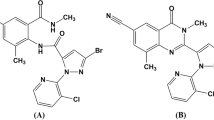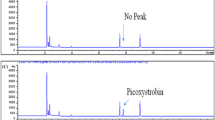Abstract
A micro-liquid-liquid extraction (MLLE) technique coupled with liquid chromatography tandem mass spectrometry (LC-MS/MS) analysis was established and validated to determine the residues of two macrocyclic lactone insecticides (spinetoram and spinosad) in green onion. The limit of quantification (LOQ) of the method, as demonstrated by the lowest acceptable recovery level, was 0.01 mg kg−1, and the obtained recoveries were 78.3–93.4% with relative standard deviations (RSDs) < 12.5%. The method was then applied for analyzing field samples collected after treatment with the tested insecticides under Egyptian open-field condition. The decline pattern, terminal residues, and dietary risk assessment of spinetoram and spinosad residues in green onion were evaluated for food safety. Spinetoram and spinosad residues’ decline in green onion followed first-order kinetics with the half-lives of 1.2 and 1.42 days, respectively. Based on the results, the required period to reach their respective maximum residue limits (MRLs) was 1 and 0 days for spinetoram and spinosad residues in green onion, respectively, which indicates a short persistence level and high degradation rate. The results suggest that there is no unacceptable chronic or acute risk to human health from the consumption of green onion treated with spinetoram and spinosad according to the uses considered.


Similar content being viewed by others
References
Abd Allah, O., El Agamy, M., Hassan, E., & Malhat, F. (2019). Buprofezin dissipation and safety assessment in open field cabbage and cauliflower using GC/IT MS employing an analyte protectant. Biomedical Chromatography, e4492. https://doi.org/10.1002/bmc.4492.
Adak, T., & Mukherjee, I. (2016). Dissipation kinetics of spinosad from tomato under sub-tropical agro-climatic conditions. Environmental Monitoring and Assessment, 188(5), 299.
Adel, A. H., Safaa, M. H., Salah, M. G., & Mahamed, S. M. (2016). Determination of spinetoram residues degradation in tomato fruits using high performance liquid chromatography (HPLC) and QuECHERS method. Egyptian Scientific Journal of Pesticides, 2(3), 8–12.
Anastassiades, M., Lehotay, S. J., Štajnbaher, D., & Schenck, F. J. (2003). Fast and easy multiresidue method employing acetonitrile extraction/partitioning and “dispersive solid-phase extraction” for the determination of pesticide residues in produce. Journal of AOAC International, 86(2), 412–431.
Dasenaki, M. E., Bletsou, A. A., Hanafi, A. H., & Thomaidis, N. S. (2016). Liquid chromatography–tandem mass spectrometric methods for the determination of spinosad, thiacloprid and pyridalyl in spring onions and estimation of their pre-harvest interval values. Food Chemistry, 213, 395–401.
EU_Pesticide_database. (2018). http://ec.europa.eu/food/plant/pesticides/eu-pesticides-database/public/?event=pesticide.residue.selection&language=EN. Accessed 8.07.18.
FAOSTAT. (2018). Food and agriculture organization of the united nation Available at: http://faostat.fao.org/. Accessed 10 July 2018.
Ferrer, C., Lozano, A., Agüera, A., Girón, A. J., & Fernández-Alba, A. R. (2011). Overcoming matrix effects using the dilution approach in multiresidue methods for fruits and vegetables. Journal of Chromatography A, 1218(42), 7634–7639. https://doi.org/10.1016/j.chroma.2011.07.033.
Fidente, P., Seccia, S., Vanni, F., & Morrica, P. (2005). Analysis of nicotinoid insecticides residues in honey by solid matrix partition clean-up and liquid chromatography–electrospray mass spectrometry. Journal of Chromatography A, 1094(1–2), 175–178.
Figueroa, J. I., Coronado, R. E., Pineda, S., Chavarrieta, J. M., & Martínez-Castillo, A. M. (2015). Mortality and food consumption in Spodoptera frugiperda (Lepidoptera: Noctuidae) larvae treated with spinosad alone or in mixtures with a nucleopolyhedrovirus. Florida Entomologist, 98(3), 1009–1011.
Gao, R., Dong, J., Zhang, W., & Chen, W. L. (2007). Dietary risk assessment of spinosad in China. Regulatory Toxicology and Pharmacology, 49(1), 31–42.
Hajšlová, J., & Zrostlıkova, J. (2003). Matrix effects in (ultra) trace analysis of pesticide residues in food and biotic matrices. Journal of Chromatography A, 1000(1–2), 181–197.
Huan, Z., Luo, J., Xu, Z., & Xie, D. (2015). Residues, dissipation, and risk assessment of spinosad in cowpea under open field conditions. Environmental Monitoring and Assessment, 187(11), 706.
Jin, Z.-H., Wu, J.-P., Zhang, Y., Cheng, X., Yang, L.-R., & Cen, P.-L. (2006). Improvement of spinosad producing Saccharopolyspora spinosa by rational screening. Journal of Zhejiang University-Science A, 7(2), 366–370.
Kamel, A. (2010). Refined methodology for the determination of neonicotinoid pesticides and their metabolites in honey bees and bee products by liquid chromatography− tandem mass spectrometry (LC-MS/MS). Journal of Agricultural and Food Chemistry, 58(10), 5926–5931.
Lan, Z., Zhao, C., Guo, W., Guan, X., & Zhang, X. (2015). Optimization of culture medium for maximal production of spinosad using an artificial neural network-genetic algorithm modeling. Journal of Molecular Microbiology and Biotechnology, 25(4), 253–261.
Liang, H., Li, L., Li, W., Wu, Y., Zhou, Z., & Liu, F. (2011). Dissipation and residue of dimethomorph in pepper and soil under field conditions. Ecotoxicology and Environmental Safety, 74(5), 1331–1335.
Liu, X., El-Aty, A. A., Park, J. Y., Park, J. H., Cho, S. K., Shin, H. C., & Shim, J. H. (2011). Determination of spinetoram in leafy vegetable crops using liquid chromatography and confirmation via tandem mass spectrometry. Biomedical Chromatography, 25(10), 1099–1106.
Liu, Y., Sun, H., & Wang, S. (2013). Dissipation and residue of spinosad in zucchini under field conditions. Bulletin of Environmental Contamination and Toxicology, 91(2), 256–259.
Malhat, F. (2012). Determination of chlorantraniliprole residues in grape by high-performance liquid chromatography. Food Analytical Methods, 5(6), 1492–1496.
Malhat, F. M. (2013). Simultaneous determination of spinetoram residues in tomato by high performance liquid chromatography combined with QuEChERS method. Bulletin of Environmental Contamination and Toxicology, 90(2), 222–226.
Malhat, F., Malhat, F., & Hassan, A. (2011). Level and fate of etoxazole in green bean (Phaseolus vulgaris). Bulletin of Environmental Contamination and Toxicology, 87(2), 190–193. https://doi.org/10.1007/s00128-011-0336-6.
Malhat, F., Badawy, H. M. A., Barakat, D. A., & Saber, A. N. (2014). Residues, dissipation and safety evaluation of chromafenozide in strawberry under open field conditions. Food Chemistry, 152, 18–22. https://doi.org/10.1016/j.foodchem.2013.11.110.
Malhat, F., Boulangé, J., Abdelraheem, E., Abd Allah, O., Abd El-Hamid, R., & Abd El-Salam, S. (2017). Validation of QuEChERS based method for determination of fenitrothion residues in tomatoes by gas chromatography-flame photometric detector: decline pattern and risk assessment. Food Chemistry, 229, 814–819. https://doi.org/10.1016/j.foodchem.2017.03.017.
Malhat, F., Kasiotis, K. M., & Shalaby, S. (2018). Magnitude of cyantraniliprole residues in tomato following open field application: pre-harvest interval determination and risk assessment. Environmental Monitoring and Assessment, 190(3), 116. https://doi.org/10.1007/s10661-018-6496-7.
Mandal, K., Jyot, G., & Singh, B. (2009). Dissipation kinetics of spinosad on cauliflower (Brassica oleracea var. botrytis. L.) under subtropical conditions of Punjab, India. Bulletin of environmental contamination and toxicology, 83(6), 808.
Mertz, F. P., & Yao, R. C. (1990). Saccharopolyspora spinosa sp. nov. isolated from soil collected in a sugar mill rum still. International Journal of Systematic and Evolutionary Microbiology, 40(1), 34–39.
Nault, B. A., Hsu, C. L., & Hoepting, C. A. (2013). Consequences of co-applying insecticides and fungicides for managing Thrips tabaci (Thysanoptera: Thripidae) on onion. Pest Management Science, 69(7), 841–849. https://doi.org/10.1002/ps.3444.
Park, K. H., Choi, J.-H., El-Aty, A. A., Cho, S.-K., Park, J.-H., Kim, B. M., & Im, G.-J. (2012). Determination of spinetoram and its metabolites in amaranth and parsley using QuEChERS-based extraction and liquid chromatography–tandem mass spectrometry. Food Chemistry, 134(4), 2552–2559.
Saber, A. N., Malhat, F. M., Badawy, H. M. A., & Barakat, D. A. (2016). Dissipation dynamic, residue distribution and processing factor of hexythiazox in strawberry fruits under open field condition. Food Chemistry, 196, 1108–1116. https://doi.org/10.1016/j.foodchem.2015.10.052.
SANTE/11813/2017. Guidance document on analytical quality control and method validation procedures for pesticide residues and analysis in food and feed. Implemented by 01/01/2018.
Sharma, A., Srivastava, A., Ram, B., & Srivastava, P. C. (2007). Dissipation behaviour of spinosad insecticide in soil, cabbage and cauliflower under subtropical conditions. Pest Management Science: formerly Pesticide Science, 63(11), 1141–1145.
Singh, S., & Battu, R. (2012). Dissipation kinetics of spinosad in cabbage (Brassica oleracea L. var. capitata). Toxicological & Environmental Chemistry, 94(2), 319–326.
Somers, J., Nguyen, J., Lumb, C., Batterham, P., & Perry, T. (2015). In vivo functional analysis of the Drosophila melanogaster nicotinic acetylcholine receptor Dα6 using the insecticide spinosad. Insect Biochemistry and Molecular Biology, 64, 116–127.
Srinivas, P. S., Banerjee, K., Jadhav, M. R., Ghaste, M. S., & Lawande, K. (2012). Bioefficacy, dissipation kinetics and safety evaluation of selected insecticides in Allium cepa L. Journal of Environmental Science and Health, Part B, 47(7), 700–709.
Ueno, E., Oshima, H., Matsumoto, H., Saito, I., & Tamura, H. (2006). Determination of spinosad in vegetables and fruits by high-performance liquid chromatography with UV and mass spectrometric detection after gel permeation chromatography and solid-phase extraction cleanup on a 2-layered column. Journal of AOAC International, 89(6), 1641–1649.
Vassilakos, T. N., & Athanassiou, C. G. (2015). Long-term residual efficacy of spinetoram on concrete and steel surfaces for the management of three stored product beetle species. Journal of Economic Entomology, 108(4), 2090–2097.
Vijayasree, V., Bai, H., Mathew, T. B., George, T., Xavier, G., Kumar, N. P., & Visalkumar, S. (2014). Dissipation kinetics and effect of different decontamination techniques on the residues of emamectin benzoate and spinosad in cowpea pods. Environmental Monitoring and Assessment, 186(7), 4499–4506.
West, S. D., & Turner, L. G. (2000). Determination of spinosad and its metabolites in citrus crops and orange processed commodities by HPLC with UV detection. Journal of Agricultural and Food Chemistry, 48(2), 366–372.
West, S. D., Yeh, L.-T., Turner, L. G., Schwedler, D. A., Thomas, A. D., & Duebelbeis, D. O. (2000). Determination of spinosad and its metabolites in food and environmental matrices. 1. High-performance liquid chromatography with ultraviolet detection. Journal of Agricultural and Food Chemistry, 48(11), 5131–5137.
Wilson, R. G., Orloff, S. B., & Taylor, A. G. (2015). Evaluation of insecticides and application methods to protect onions from onion maggot, Delia antiqua, and seedcorn maggot, Delia platura, damage. Crop Protection, 67, 102–108. https://doi.org/10.1016/j.cropro.2014.10.002.
Zhao, L., Chen, G., Zhao, J., Zhang, Y., Zhu, Y., Yang, T., & Wu, Y.-L. (2015). Degradation kinetics of the insecticide spinetoram in a rice field ecosystem. Chemosphere, 119, 1185–1191.
Acknowledgments
The authors thank all members and staff of Pesticide Residues and Environmental Pollution Department, Central Agricultural Pesticides Laboratory, Agriculture Research Center, Egypt, for their technical assistance.
Author information
Authors and Affiliations
Corresponding author
Additional information
Publisher’s note
Springer Nature remains neutral with regard to jurisdictional claims in published maps and institutional affiliations.
Rights and permissions
About this article
Cite this article
Malhat, F., Abdallah, O. Residue distribution and risk assessment of two macrocyclic lactone insecticides in green onion using micro-liquid-liquid extraction (MLLE) technique coupled with liquid chromatography tandem mass spectrometry. Environ Monit Assess 191, 584 (2019). https://doi.org/10.1007/s10661-019-7752-1
Received:
Accepted:
Published:
DOI: https://doi.org/10.1007/s10661-019-7752-1




